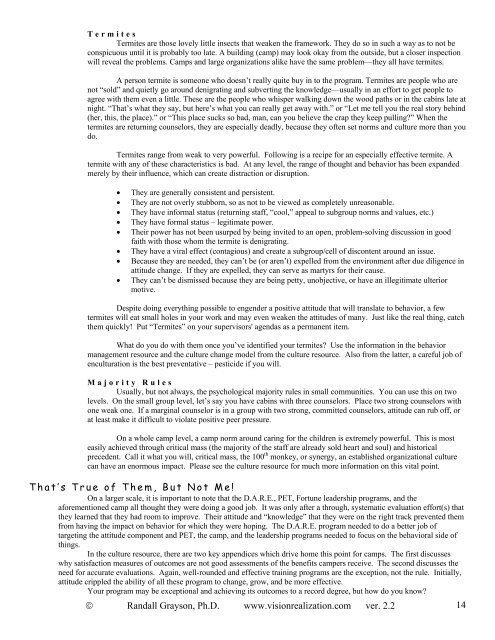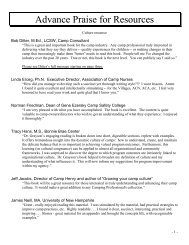Taking Camp Staff Training From Good To Best ... - Vision Realization
Taking Camp Staff Training From Good To Best ... - Vision Realization
Taking Camp Staff Training From Good To Best ... - Vision Realization
You also want an ePaper? Increase the reach of your titles
YUMPU automatically turns print PDFs into web optimized ePapers that Google loves.
Termites<br />
Termites are those lovely little insects that weaken the framework. They do so in such a way as to not be<br />
conspicuous until it is probably too late. A building (camp) may look okay from the outside, but a closer inspection<br />
will reveal the problems. <strong>Camp</strong>s and large organizations alike have the same problem—they all have termites.<br />
A person termite is someone who doesn’t really quite buy in to the program. Termites are people who are<br />
not “sold” and quietly go around denigrating and subverting the knowledge—usually in an effort to get people to<br />
agree with them even a little. These are the people who whisper walking down the wood paths or in the cabins late at<br />
night. “That’s what they say, but here’s what you can really get away with.” or “Let me tell you the real story behind<br />
(her, this, the place).” or “This place sucks so bad, man, can you believe the crap they keep pulling?” When the<br />
termites are returning counselors, they are especially deadly, because they often set norms and culture more than you<br />
do.<br />
Termites range from weak to very powerful. Following is a recipe for an especially effective termite. A<br />
termite with any of these characteristics is bad. At any level, the range of thought and behavior has been expanded<br />
merely by their influence, which can create distraction or disruption.<br />
• They are generally consistent and persistent.<br />
• They are not overly stubborn, so as not to be viewed as completely unreasonable.<br />
• They have informal status (returning staff, “cool,” appeal to subgroup norms and values, etc.)<br />
• They have formal status – legitimate power.<br />
• Their power has not been usurped by being invited to an open, problem-solving discussion in good<br />
faith with those whom the termite is denigrating.<br />
• They have a viral effect (contagious) and create a subgroup/cell of discontent around an issue.<br />
• Because they are needed, they can’t be (or aren’t) expelled from the environment after due diligence in<br />
attitude change. If they are expelled, they can serve as martyrs for their cause.<br />
• They can’t be dismissed because they are being petty, unobjective, or have an illegitimate ulterior<br />
motive.<br />
Despite doing everything possible to engender a positive attitude that will translate to behavior, a few<br />
termites will eat small holes in your work and may even weaken the attitudes of many. Just like the real thing, catch<br />
them quickly! Put “Termites” on your supervisors' agendas as a permanent item.<br />
What do you do with them once you’ve identified your termites? Use the information in the behavior<br />
management resource and the culture change model from the culture resource. Also from the latter, a careful job of<br />
enculturation is the best preventative – pesticide if you will.<br />
Majority Rules<br />
Usually, but not always, the psychological majority rules in small communities. You can use this on two<br />
levels. On the small group level, let’s say you have cabins with three counselors. Place two strong counselors with<br />
one weak one. If a marginal counselor is in a group with two strong, committed counselors, attitude can rub off, or<br />
at least make it difficult to violate positive peer pressure.<br />
On a whole camp level, a camp norm around caring for the children is extremely powerful. This is most<br />
easily achieved through critical mass (the majority of the staff are already sold heart and soul) and historical<br />
precedent. Call it what you will, critical mass, the 100 th monkey, or synergy, an established organizational culture<br />
can have an enormous impact. Please see the culture resource for much more information on this vital point.<br />
That’s True of Them, But Not Me!<br />
On a larger scale, it is important to note that the D.A.R.E., PET, Fortune leadership programs, and the<br />
aforementioned camp all thought they were doing a good job. It was only after a through, systematic evaluation effort(s) that<br />
they learned that they had room to improve. Their attitude and “knowledge” that they were on the right track prevented them<br />
from having the impact on behavior for which they were hoping. The D.A.R.E. program needed to do a better job of<br />
targeting the attitude component and PET, the camp, and the leadership programs needed to focus on the behavioral side of<br />
things.<br />
In the culture resource, there are two key appendices which drive home this point for camps. The first discusses<br />
why satisfaction measures of outcomes are not good assessments of the benefits campers receive. The second discusses the<br />
need for accurate evaluations. Again, well-rounded and effective training programs are the exception, not the rule. Initially,<br />
attitude crippled the ability of all these program to change, grow, and be more effective.<br />
Your program may be exceptional and achieving its outcomes to a record degree, but how do you know?<br />
© Randall Grayson, Ph.D. www.visionrealization.com ver. 2.2 14





